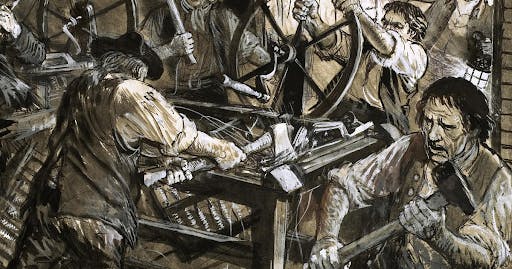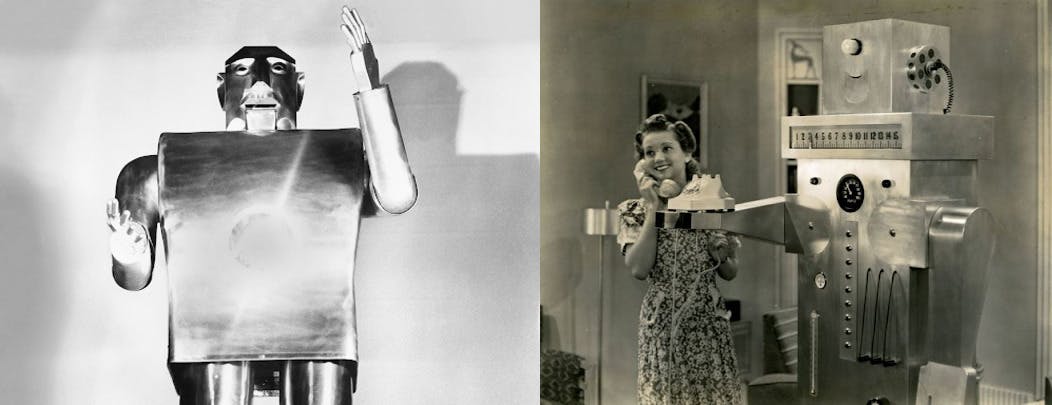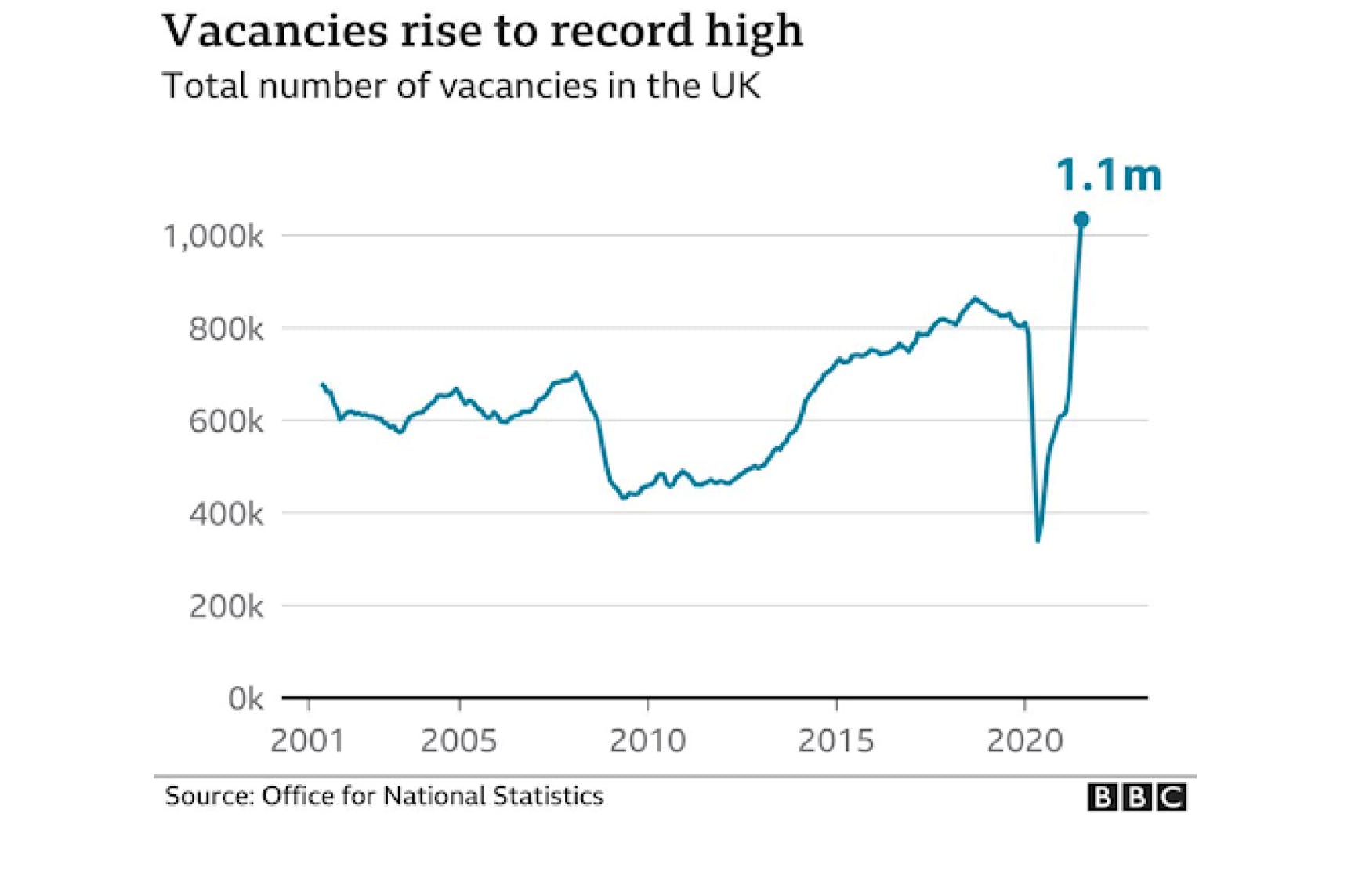Will artificial intelligence really take over jobs?

Share On
The Golden Age of AI
Artificial intelligence always progresses forward. It can do parkour now, and predict pandemics before the rest of us even have a clue.
Then again, today’s AI pales in comparison to where we expected it to be by now.
In the Spring of 1939, an exhibit at the World’s Fair in Queens, NY showed citizens a view of what their AI future might hold. It came in the form of a 7-foot-tall, 265-pound hunk of aluminum. It—he—was called “Elektro.”
Amazed passersby gazed up at Elektro as he performed on stage with a handler. He demonstrated how he could walk, count on his fingers, and blow up balloons. When his handler placed a cigarette in his mouth, he started to smoke it. At one point his handler asked:
“Alright Elektro, will you tell your story please?”
“Who, me?” replied the bot.
“Yes, you.”
“Okay, toots.”

Elektro (left) and Roll-Oh (right). Images from IEEE Spectrum and 'The Old Robots' respectively
Elektro was relatively lazy, as robots go. He smoked and made jokes. In that sense, he was upstaged by his successor.
The next World’s Fair debuted “Roll-Oh”: a leaner, more robust automaton that could do anything you’d need around the house: cutting, cleaning, answering the door. With Roll-Oh’s array of skills, it was only a matter of time before he took over for housewives, and even for the men, too, in their factories and offices.
So that was 1939/40: Elektro to Roll-Oh, in 365 days. If you’d been around at the time, you might have thought intelligent machines were right around the corner—that they’d be living among us by the ‘50s.
But that, of course, didn’t happen.
And yet, eight decades on, we still have the same dreams, and the same fears. We’re still building Elektros, but now we call them Sophia. We still imagine intelligent or sentient robots are about to overtake our home and work lives, even though they haven’t quite yet.
We’ve been wrong about it before. Is this time different?
Why Experts Worry About AI
A lot of very smart people are worried about the impact that artificial intelligence could have on employment.
According to the Brookings Institute, for example, intelligent machines will gradually take over more and more complex jobs in the near future. To stay ahead of this creeping threat, coming generations will have to shift careers multiple times in their working lives.
Many experts go further. In 2014, the Pew Research Center asked 1,896 experts for their predictions about the economic impact of AI and robotics. The result: 48% of respondents “envision a future in which robots and digital agents have displaced significant numbers of both blue- and white-collar workers—with many expressing concern that this will lead to vast increases in income inequality, masses of people who are effectively unemployable, and breakdowns in the social order.” Some told Pew that it’s not a matter of certain jobs being automated, but the entire spectrum of human work becoming redundant.
We are approaching the time when machines will be able to outperform humans at almost any task. Society needs to confront this question before it is upon us: if machines are capable of doing almost any work humans can do, what will humans do?” -Moshe Vardi
The question isn’t how to train people for nonexistent jobs, it’s how to share the wealth in a world where we don’t need most people to work.” -Nathaniel Borenstein
The most commonly-cited, most comprehensive study into the matter was conducted at Oxford University in 2013. In “The Future of Employment,” two researchers systematically calculated the likelihood that 702 specific, distinct occupations would become automated. This was the result:

Images captured from “The Future of Employment” by Frey and Osborne
The volume of each color in the graph represents the total population of workers in that specific field in the U.S., with 47% having a “high” probability of computerization. According to the authors, workers in this category will likely be automated away within a decade or two.
It’s worth noting, though, that this analysis was completed in 2013. Nearly a decade on, few of its predictions have even begun to bear out.
Take, for instance, “office and administrative support”--perhaps the most at-risk sector, according to the study. Bureau of Labor Statistics data indicates that, since 2010, employment in this sector has grown significantly.
Or consider the service industry. The Oxford researchers concluded that waiters, hospitality workers, and the like were at risk due to “the recent growth in the market for service robots and the gradually [sic] diminishment of the comparative advantage of human labour in tasks involving mobility and dexterity.” At the turn of 2022, though, we’re experiencing quite the opposite. You’ve never been waited on by a dexterous robot, and there’s a bona fide shortage in service jobs —1.5 million openings across America as of August.
So what’s happening here? Why has our rapidly growing AI had such remarkably little effect on the job market thus far?
Why AI Won’t Take Over Jobs
Over and over again, when it comes to AI and jobs, economists point to a simple misunderstanding. It’s a misunderstanding that’s been around for centuries, even among highly intelligent people.
During the Great Depression, for example, as unemployment in America reached its highest point ever, politicians were scrambling to figure out how to get more citizens back to work. So the Senate passed a bill, with President Franklin Roosevelt’s approval, to shorten the standard workweek to just 30 hours. Roosevelt’s predecessor, Herbert Hoover, had advocated for something similar where workers would voluntarily share their hours in larger groups, each individual doing a lesser portion of the total. These policies were grounded in a belief that there is a single, fixed amount of available work for people to do.
But that’s just not true.
Economists have deemed this the “lump of labor fallacy.” As it applies to technologies, we call it the “Luddite fallacy,” after the 19th century English textile workers who protested the automation of their labor. The idea here is that the supply of available work in the economy is not static. Instead, as workers are replaced by machines, two things happen:
New jobs are created in collaboration with those machines (maintenance, programming, etc…)
Productivity increases and production costs decrease, resulting in more societal wealth which translates to new jobs elsewhere in the economy
Take the Luddites. They suffered for having lost their jobs, surely. But with cheaper machine work, manufacturers could make clothing for less money, and pass on those savings to customers. With access to cheaper clothing, all English citizens had more disposable income to spend elsewhere. As their spending on other goods increased, more labor was needed in those other industries.
The same kind of thing is happening today, right now, with artificial intelligence.
The Last Time AI Threatened To Take Our Jobs
Last summer the whole world was on fire, and it was only getting worse.
COVID-19 hadn’t merely taken more jobs than the Great Depression — by most accounts, a lot of those jobs were gone for good. In California, The Associated Press interviewed a fast-food chain owner who was replacing his workers with a voice assistant AI. “It doesn’t call [in] sick,” the man told reporters. “It doesn’t get corona. And the reliability of it is great.” According to the BBC, the same kind of automation was occurring across restaurants and grocery stores. t Walmart, where many workers already don’t clear the poverty line, robots were being deployed to replace janitors.
It was these most vulnerable people (medium-, but especially low-wage workers) who were the most at risk of replacement. Elsewhere in California, for example, Time Magazine reported that hundreds of toll booth operators were being let go. The article made an alarming prediction: that, of the 40 million U.S. jobs lost during the pandemic, many were never going to return. According to “one group of economists” cited, around 42% would remain lost forever.
That was last summer. This summer, you’d have to say, was a bit different.
The news channels have deemed it “The Great Resignation.” Millions of people, burned out and looking for a change in lifestyle, have all been leaving their jobs. According to the Bureau of Labor Statistics, roughly 4 million Americans have quit every month now since April. Other countries are experiencing this as well, like China, Germany, and the U.K., where there are more than 1,000,000 unfilled jobs for the first time in history.

Image via the BBC
In an unexpected 180-degree twist, it’s been some of the most vulnerable (the medium- and low-wage workers) who have been most liberated. In the U.S., quitting has been three times more common in the southern states than the more affluent northeast, and nearly 20% of all quitters left the hospitality and food service industries.
All of a sudden, business owners have been scrambling for the very workers they were purportedly replacing.
Where are all the robots now?
They’re still there, for the most part. But the economy is far healthier, and far more robust than it was at the peak of the pandemic. Spending is as high as it’s ever been, and so for every toll booth operator who’s lost out to a robot, there’s an empty spot at a retail store or a restaurant with renewed business, an empty driver’s seat in a freight truck, or an open role at a technology company that’s building the AI that keeps this cycle going..
So, Will AI Take Over Jobs?
People have been imagining, speculating and worrying about machines taking their jobs since 1940 and beyond. Yet, in the time since, as digital adoption has gone like this…

Graph by Visual Capitalist
Unemployment has stayed like this…

Graph by the U.S. BLS
Some argue that this time is different. If that were true, the COVID-19 pandemic—when workers literally weren’t allowed to go into work—should have been an inflection point. Instead, it was merely a flash in the pan. AI hasn’t created any long-term, large-scale unemployment. Is there any evidence that it will?
Well, this year, Forbes published their “AI 50 2021,” a list of America’s 50 fastest growing and most exciting companies in the space. Among the top 50 are startups that help doctors screen for cancer, help people learn languages, and help farmers get rid of weeds. Some track cargo ships as they sail the oceans, and one helps construction workers install drywall. These algorithms are going to make us safer, smarter, more efficient and more productive. But none of them threaten to put doctors, teachers, farmers, sailors or construction workers out on the street.
Even Elektro and Roll-O —the robots that could do anything —didn’t really threaten to take anyone’s job. Elektro was too lazy; too busy smoking cigarettes and cracking wise. And Roll-Oh, his straight-edged successor, only ended up creating new jobs.
AI does take over jobs. Then it creates new ones.
Comments (9)
Henry Fieldse@taryn_corkery
Well, complex jobs will be taken over by machines with artificial intelligence in the near future. Generations to come will have to change careers a number of times over the course of their working life to keep up with this threat. I will visit https://www.assignmentmasters.co.uk/btec-assignment/ website to get help in my technological assignments.
Share
Great Learning
Free https://theimpossiblequiz.io is a popular quiz game with lots of tricky questions.

Neuralfinity
Great article. We are working on AI startup, thank you for true words!
It all comes down to necessity. Not every job can be replaced by AI. For example, real estate agents is a job that cannot be replaced by a robot. The search platforms for buying and selling real estate estate are powered by AI, but to show a wealthy person the property, it reacquires a real human to take care of this task.
More stories

Vaibhav Gupta · Opinions · 10 min read
3.5 Years, 12 Hard Pivots, Still Not Dead
Kyle Corbitt · How To · 5 min read
A Founder’s Guide to AI Fine-Tuning

Chris Bakke · How To · 6 min read
A Better Way to Get Your First 10 B2B Customers

Keegan Walden · Maker Stories · 7 min read
The inner work of startup building


